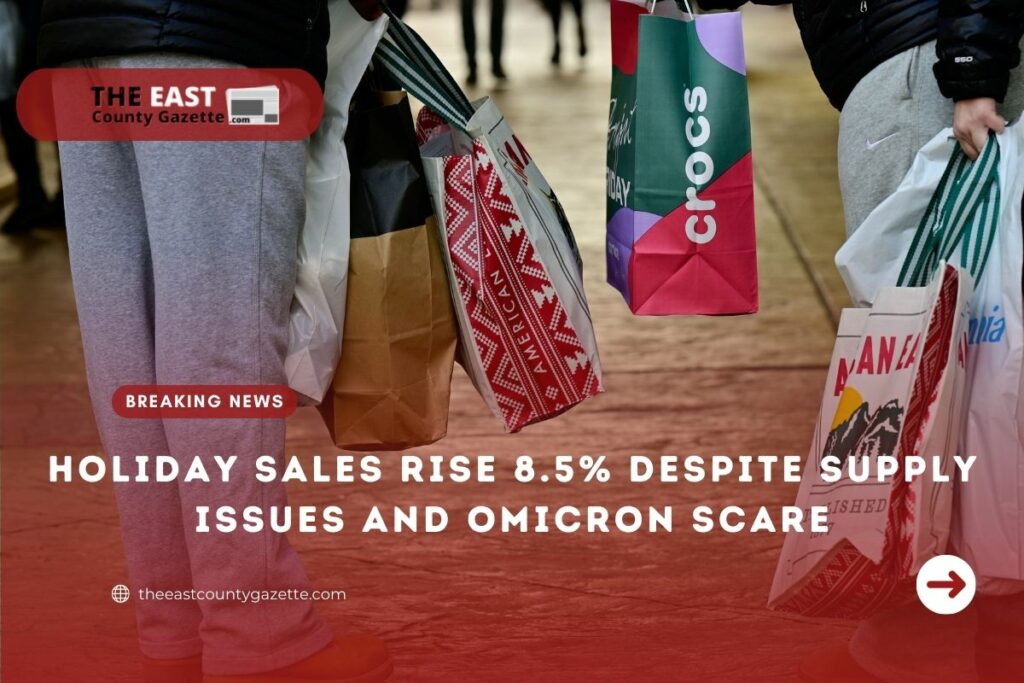A measure of holiday spending shows that sales surged at the fastest pace in 17 years during the last few weeks of the holiday season despite higher prices, shortages, and a volatile COVID-19 variant.
MasterCard SpendingPulse, which tracks a variety of payment methods including cash and debit cards, revealed holiday sales increased 8.5 percent from a year earlier. According to MasterCard SpendingPulse, an 8.8 percent rise was expected.
According to APnews, purchases of clothing and jewelry dominated the results between Nov. 1 and Dec. 24.
Compared with the pre-pandemic holiday period, holiday sales increased by 10.7%.
Clothes grew 47 percent, jewelry 32 percent, electronics 16 percent. There was an increase of 11 percent in online sales from the year before and a 61 percent increase from 2019. In department stores, sales were up 21 percent too.
Several consumers stayed home and switched to online shopping after Omicron hit — but sales remained strong nevertheless.
“I feel really good about how the season played out,” said Steve Sadove, former CEO of Saks Inc and senior adviser to Mastercard.
“When people feel a little bit uncomfortable, you’ll see a little bit of a pickup in online and a little bit of a slowdown in-store performance.’’
National Retail Federation, the nation’s largest retail trade group, will release a combined two-month report in mid-January that will provide a more comprehensive picture of these sales.
Read More: Parents can claim child tax credits of $1,800 or $3,600 in simply 5 days. Here’s how?
The results will be determined by analyzing the December and November Commerce Department sales figures. Furthermore, analysts will scrutinize the results of different retailers who are due to release their fourth-quarter financials in February.
It was known that analysts predict a strong holiday season, with early shopping anticipating a product shortage starting back in October. After a muted holiday season last year, consumers were also determined to celebrate this season. Retail sales declined in November, partly as a result of the early holiday shopping.
Moreover, omicron, the most dominating variant of the virus currently circulating in America, has ruined many Americans’ plans for the holiday season by requiring them to cancel last-minute gatherings.
Early in December, the National Retail Federation predicted holiday sales would surpass expectations by between 8.5 percent and 10.5 percent. In fact, holiday sales rose 8.2 percent in 2020, as shoppers blew money on pajamas and home goods, mostly online, as the pandemic began. Including online sales and other non-store sales in the total, the group anticipates an 11 to 15 percent increase. Restaurants, gas stations, and automobile dealers are not included in these figures. Over the past five years, holiday sales have increased by 4.4% on average.
In early December, the NRF provided an update ahead of omicron’s emergence as a big threat across all industries, from Broadway theaters to restaurants. Although some big city stores have reported a drop in traffic, overall store traffic has not dropped.
Data from Sensormatic Solutions shows store traffic was slightly up for the week ending Dec. 18, compared to a year earlier, but down 23% from the same week in the pre-pandemic year of 2019. As the senior manager of Sensormatic’s retail consulting group noted, shoppers are still going to stores, but they prefer shopping malls and open-air centers over enclosed centers.
A challenging economic environment has hamstrung some retailers, but retail sales have continued to rise. In order to find and keep workers, businesses have had to dramatically raise pay. Several major U.S. ports are still backed up, meaning bussinesses were scrambling to fill shelves.
American resilience was demonstrated in several ways at the same time. Food and gas were more expensive, putting pressure on holiday shoppers’ wallets. Over the past year, consumer prices increased by 5.7 percent, the highest rate in 39 years. As the holidays approach, Americans find themselves dealing with an inflation spike. November’s increase follows a 5.1 percent raise for the previous 12 months ended in October, the Commerce Department announced Thursday. Inflation has risen above the Federal Reserve’s target of 2% for a string of years.
In addition to finding alternatives, Americans also learned to adjust to shortages, searching for top brands on eBay and other sites if their top choices weren’t available.
The big-box retailers like Target and Walmart said their shelves would be stocked for Thanksgiving, but elsewhere, goods are scarce. Speaking with The Associated Press, Target CEO Brian Cornell predicted clogs in the supply chain will take several years to clear.

